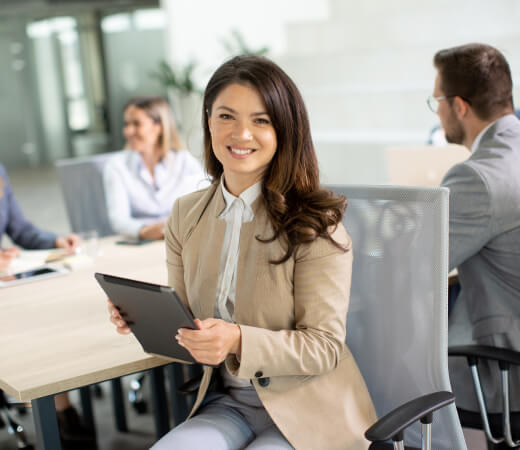Measuring and optimizing business performance metrics is crucial for success in today’s business world. This blog post highlights the key learnings from our new eBook, “Foster Long-Term Profitability with Must-Have KPIs,” which serves as a comprehensive guide on using Key Performance Indicators (KPIs) to guide your business’s operational efficiency, financial health, and customer satisfaction. Download your copy now (Instant Access. No form required!) to transform your approach to performance management!
Data-driven decision-making starts with metrics tracking
Key Performance Indicators (KPIs) are not just numbers; they are vital tools that enable businesses to quantify and track their progress toward strategic goals. Integrating KPIs into your business strategy allows for effective performance analysis and informed decision-making, fostering a culture of continuous improvement. By adopting a metrics-driven approach, businesses can:
- Measure effectiveness across various functions, from operations to customer interactions.
- Identify opportunities for improvement and adjust strategies dynamically.
- Enhance alignment between employee actions and business objectives.

Building a Successful KPI Strategy for Optimal Business Performance
Building a successful KPI strategy involves more than just selecting the right metrics; it requires a comprehensive approach that includes aligning KPIs with business goals, establishing a robust reporting mechanism, adapting to changes, ensuring organizational engagement, and leveraging technology for enhanced data analysis. Our eBook provides a framework for leaders looking to develop a performance metrics strategy, including:
1. Defining objectives and aligning KPIs accordingly
Start by clearly defining your business goals to ensure the KPIs you choose directly support these objectives. This alignment ensures that every metric you track is purposefully contributing to your strategic targets.
2. Understand and select the relevant KPIs to focus on
Not all KPIs are equally valuable for every business. It’s crucial to select metrics most relevant to your specific industry, operational scope, and strategic goals to ensure effective monitoring and management.
3. Avoid common pitfalls in KPI implementation:
Implementing KPIs can be fraught with challenges like overcomplicating metrics, focusing on vanity metrics, or poor communication of their importance. Address these issues upfront to maximize the effectiveness of your KPI strategy.
4. Foster organizational buy-in
Achieving the full benefit of KPIs requires buy-in from all levels of the organization. Engage team members through training, clear communication, and involving them in the selection process to foster a metrics-driven culture.
5. Establish a reporting system for metrics tracking
Develop a robust reporting system that allows for regular review and analysis of KPIs. This system should enable easy access to data for all stakeholders, facilitating timely decisions and continuous improvement.
6. Utilize technology to enhance KPI tracking
Leverage advanced technology solutions to automate data collection, analysis, and reporting. This increases the accuracy and efficiency of your KPI tracking and allows for real-time insights that can drive quicker strategic adjustments.
A strategic KPI framework not only clarifies the pathway toward achieving business objectives but also embeds a culture of continuous improvement within the organization. Companies can enhance decision-making and drive sustainable growth by meticulously defining, selecting, and aligning KPIs with business goals, establishing robust reporting mechanisms, and leveraging technology. This comprehensive approach to KPI strategy ensures that businesses not only remain competitive but are also well-equipped to adapt to changing market dynamics and internal shifts.
Mapping Out KPIs Across Business Functions for Strategic Advantage
Our eBook provides a comprehensive overview of the various types of KPIs, each serving specific purposes and collectively shaping a holistic view of business health in the following key categories:
- General Business and Financial metrics
- Sales and Marketing KPIs
- Customer Support and Satisfaction performance metrics
- Operations and Workforce Productivity critical success indicators
- IT and Digital Transformation
- HR and Employee Satisfaction
Financial KPIs: Monitoring Fiscal Health and Profitability
Financial benchmarks are crucial for assessing a business’s economic stability and profitability. These metrics provide insights into revenue streams, expense management, and overall financial performance, enabling leaders to make informed decisions about budget allocations, investment opportunities, and cost-saving measures. Common financial KPIs include:
- Gross Profit Margin: Measures the percentage of revenue remaining after deducting the cost of goods sold, highlighting efficiency in production and pricing strategies.
- Net Profit Margin: Indicates the percentage of revenue that translates into profit after all expenses, providing a clear view of overall financial health.
- Return-on-Investment (ROI): Calculates the efficiency and profitability of investments, helping businesses identify lucrative opportunities and reassess underperforming assets.
Understanding these categories is crucial for applying the right metrics to pertinent aspects of your business. This allows you to pinpoint areas needing attention, which is essential for maintaining a competitive edge and sustainable growth.
Operational KPIs: Enhancing Efficiency and Productivity
Operational KPIs focus on the efficiency and effectiveness of business processes. These metrics are instrumental in identifying bottlenecks, optimizing workflows, and improving resource allocation. Effective operational efficiency KPIs enable businesses to maintain high productivity levels and streamline operations, ultimately reducing costs and improving service delivery. Some common operational KPIs include:
- Inventory Turnover: This shows how often inventory is sold and replaced over time, indicating the effectiveness of inventory management and sales performance.
- Cycle Time: Measures the time taken to complete a business process from start to finish, helping to pinpoint delays and inefficiencies.
- Overall Equipment Effectiveness (OEE): This measure assesses how well a manufacturing operation is utilized compared to its full potential, combining metrics for quality, performance, and availability.
Organizations that effectively track and analyze these operational KPIs are better positioned to make tactical improvements that enhance productivity and operational efficiency.
Customer-Related KPIs: Fostering Engagement and Satisfaction
Customer-related KPIs provide insights into customer engagement, satisfaction, and overall service quality, which are critical for building loyalty and increasing customer lifetime value (CLV). These metrics help businesses understand customer needs, measure service effectiveness, and identify areas for improvement in customer interaction strategies. Key customer-related KPIs include:
- Customer Satisfaction Score (CSAT): Gauges the satisfaction level of customers with a company’s products or services, providing immediate feedback on consumer experiences.
- Net Promoter Score (NPS): This score reflects customers’ willingness to recommend a company’s product or service, indicating overall customer loyalty and satisfaction.
- Customer Churn Rate: Measures the rate at which customers stop doing business with a company, helping identify issues with customer retention strategies.
Businesses can enhance customer experiences, improve retention rates, and build a loyal customer base by focusing on customer-related metrics. Discover the other 9 customer satisfaction metrics in the eBook. Download the eBook for the complete list of KPIs you should be monitoring.
Leveraging Acumatica for Enhanced KPI Monitoring and Strategic Decision-Making
In a data-driven business environment, having the right tools to monitor and manage KPIs is more crucial than ever. Acumatica offers a robust, integrated solution that simplifies KPI tracking and enhances the strategic decision-making process. With its comprehensive analytics, customizable dashboards, and scalable infrastructure, Acumatica is the ideal solution for any organization looking to leverage KPIs for business success. Embrace Acumatica to transform your approach to performance management and secure a competitive edge in the dynamic market landscape with:
- Comprehensive Dashboard Customization: Tailor Acumatica dashboards to display critical metrics tailored to specific roles within your organization, ensuring all team members have instant access to the most relevant data.
- Real-Time Data Accessibility: Benefit from real-time updates on all KPIs and metrics, allowing for swift decision-making and immediate response to market changes or internal shifts.
- Advanced Reporting Tools: Utilize Acumatica’s sophisticated reporting capabilities to delve deep into data analysis, uncover trends, and generate actionable insights from your business metrics.
- Cross-Functional Integration: Enjoy seamless data integration across various business functions, such as sales, finance, operations, and customer service, providing a holistic view of business performance.
- Mobile Accessibility: Acumatica’s mobile-friendly platform allows users to access essential business metrics and KPIs on the go, ensuring crucial decision-making data is always at their fingertips, regardless of their location.
- Customizable Alerts and Notifications: Set up alerts and notifications for key metrics to stay informed about critical developments, helping prevent issues before they escalate and seize opportunities as they arise.
- Actionable Insights for Proactive Management: Transform raw data into clear, actionable insights that empower proactive management and strategic adjustments, driving better business outcomes.
- Enhanced Collaboration: Facilitate better communication and collaboration across departments with shared access to metrics and reports, aligning efforts and optimizing overall business performance.
The Strategic Advantage of KPIs
KPIs transform business performance metrics from standard measurements to strategic assets. Businesses position themselves for success and future growth by effectively understanding and utilizing KPIs. Leverage the insights from our comprehensive guide, Foster Long-Term Profitability with Must-Have KPIs, to ensure your business’s competitiveness and sustainability.
By embracing a KPI-driven approach, businesses can achieve deeper insights, make informed decisions, and drive significant improvements across all operations.
Join countless leaders who have harnessed the power of KPIs to steer their organizations toward increased profitability and success. Mastering business performance metrics begins with understanding and implementing strategic KPIs.
Download Here
Questions?
Related Resources

The Key to ERP Success: A True Implementation Partner
Read the Article


